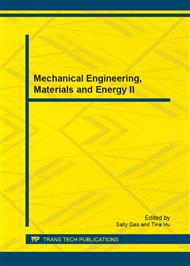p.190
p.197
p.201
p.206
p.211
p.216
p.221
p.225
p.230
Considering Thermal Deformation in Gear Transmission Error Calculation
Abstract:
This research analyze the gear for body temperature field, according to the body temperature field, it calculates comprehensive deformation of the loaded gear by using the contact method. It extracts the deformation of gear surface along the gear thickness and gear tall direction, calculating the gear non-involute error. It calculates the gear transmission error considering the thermal deformation. The results show that: Considering thermal deformation non-involute error of addendum is maximum, and there are no mutations in gear non-involute error the transmission error caused by mutation of elastic deformation mutate at single and double tooth alternating position. The bigger mutation becomes, the bigger vibration amplitude will be. The results of the study provide a solid basis to improve the motion transmission accuracy of gear.
Info:
Periodical:
Pages:
211-215
Citation:
Online since:
January 2013
Authors:
Price:
Сopyright:
© 2013 Trans Tech Publications Ltd. All Rights Reserved
Share:
Citation:


